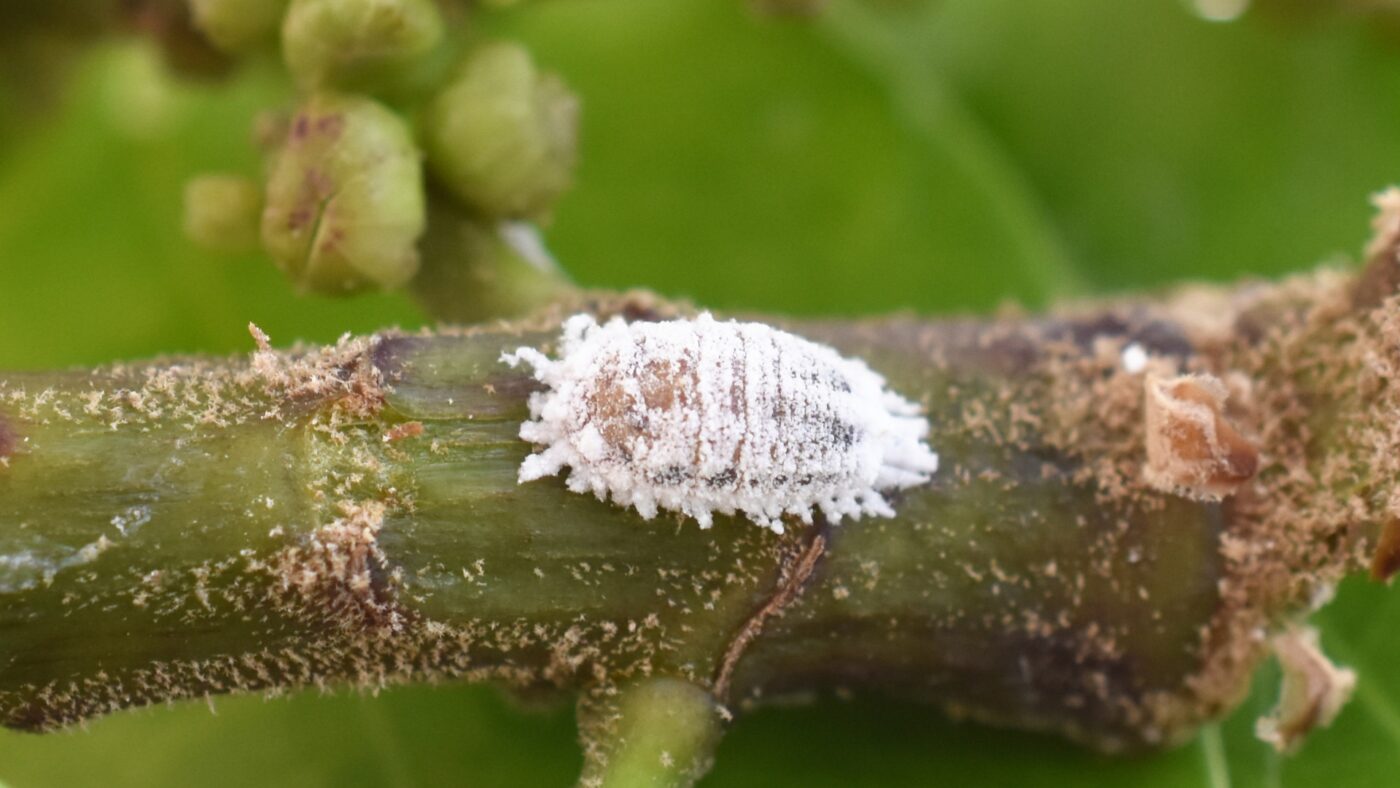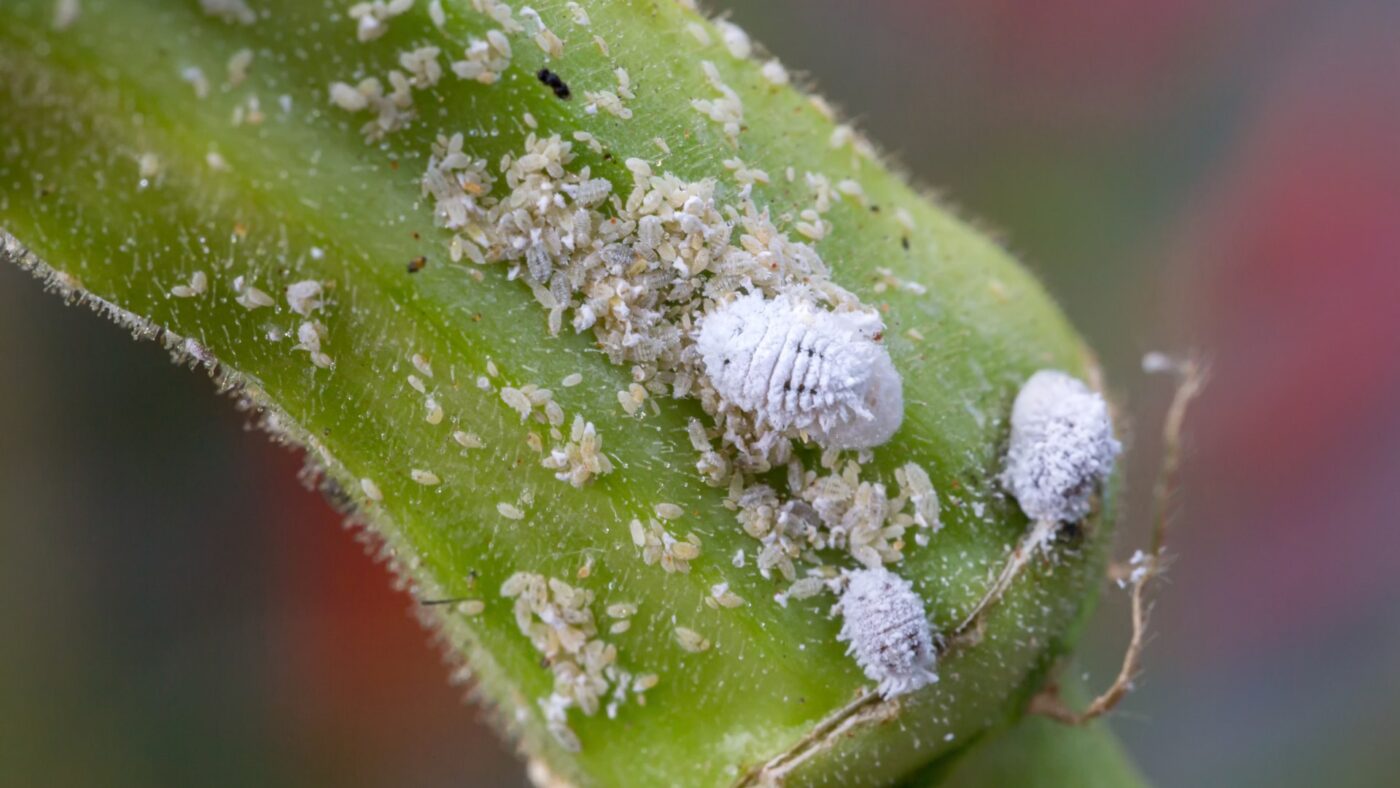Articles, Pest Management
How to Identify and Treat Mealybugs in Your Cannabis Grow

If you’ve ever spotted a weird cottony blob tucked into a stem joint, leaf vein, or root crown of your cannabis plant, chances are you’ve seen a mealybug. And if you ignored it? Well, there were probably ten more hiding just out of view.
Mealybugs are one of those pests that don’t get as much attention as mites or caterpillars, but they can cause just as much trouble, especially in warmer climates like much of South Africa. They’re slow, they’re sticky, and they multiply under your nose until one day your plant just doesn’t look right anymore.
What Are Mealybugs, Exactly?
Mealybugs are soft-bodied scale insects that belong to the Pseudococcidae family. They’re small, oval, and covered in a white, powdery wax that makes them look like little bits of cotton or lint. They don’t fly, but they crawl slowly and tend to cluster in hard-to-see places like:
- Leaf axils
- Undersides of leaves
- Stem joints
- Root crowns and even in the soil (yes, root mealybugs are a thing)
There are many species worldwide, but the most commonly found in South Africa include:
- Planococcus citri (Citrus mealybug) – widespread and often found on ornamentals, citrus, and cannabis alike
- Phenacoccus solenopsis (Cotton mealybug) – increasingly reported in parts of KwaZulu-Natal, Limpopo, and Mpumalanga
- Root mealybugs – these live below the soil line and often go unnoticed until root health starts failing
These bugs are especially fond of warm, humid, semi-enclosed environments like greenhouses and indoor grow tents, but they do just fine outdoors too if the conditions are right.
What Do They Actually Do to Your Plant?
Like aphids and whiteflies, mealybugs feed by sticking their mouthparts into the plant and sucking out sap. It’s not just about losing fluids though. Their feeding:
- Weakens overall plant health
- Stunts new growth
- Causes leaves to yellow and curl
- Reduces bud development and yield
- Leaves behind honeydew, which attracts ants and leads to sooty mold
- Opens up the plant to viruses and other diseases through wounds
Mealybugs also tend to cluster in colonies, so if you find one, there are probably many more nearby.
And don’t sleep on root mealybugs. These ones hide in the root zone and feed directly on root sap. The symptoms look like nutrient deficiency, poor root vigor, or overwatering. Plants just never really thrive, and they’re extra vulnerable to root rot.
How to Spot Them
They’re not fast, they don’t jump, and they don’t hide in plain sight unless things are out of control. Still, they’re fairly easy to find if you know what to look for.
- Cottony clusters on stems, branches, and undersides of leaves
- Sticky leaves from honeydew residue
- Black sooty mold growing on sugary excretions
- Ants farming them or defending their colonies
- Stunted growth or leaf yellowing despite adequate feeding
You can also peel back the top layer of your medium and inspect the root crown. If it looks dusty, white, and sticky, you might have root mealybugs on your hands.

Are Mealybugs a Problem in South Africa?
Definitely. In fact, mealybugs are one of the most common pests on South African fruit trees, ornamentals, and cannabis plants grown outdoors or in tunnels.
In hot, dry inland areas like parts of Gauteng and Limpopo, they thrive in coco and soil. In coastal regions like the Western Cape, especially under greenhouse plastic, they get a perfect humidity bubble to reproduce in.
Mealybugs are a major pest in citrus, and since many local growers also have citrus nearby, they often move over into cannabis grows without much notice.
Are They Hard to Get Rid Of?
Here’s the deal. Mealybugs are not fast-moving, but they are persistent, and they reproduce fast if left unchecked. Female mealybugs lay hundreds of eggs in cotton-like sacs. Once they get into a canopy or root zone, it takes regular attention and multiple approaches to get them out.
They also have a waxy coating that protects them from many sprays, so simple water or foliar applications won’t always reach them unless you saturate every surface thoroughly.
So, How Do You Deal With Mealybugs?
Start with this rule: don’t panic, but don’t wait. As soon as you see one, assume there are more and start taking action.
Step 1: Manual Removal
- Wipe off visible clusters with a Q-tip dipped in isopropyl alcohol (70 percent)
- Remove and discard heavily infested leaves or cuttings
- Prune back areas with heavy colonies to open up airflow
Step 2: Use Organic Sprays
The goal is to break the waxy barrier, so use products that coat and suffocate.
- Insecticidal soap – effective if sprayed thoroughly under and over leaves
- Neem oil – works as both a deterrent and a smothering agent
- Essential oil blends – products with clove, rosemary, or peppermint oils help repel and reduce populations
- Horticultural oil or mineral oil – great for smothering eggs and larvae
- Spinosad – kills soft-bodied insects, but not always effective on adults
Repeat applications every few days. Always spray at lights-off or dusk outdoors to avoid burning the leaves.
Step 3: Tackle the Soil
If you suspect root mealybugs, go after the root zone.
- Neem or Azadirachtin drenches – help reduce root pest activity
- Beauveria bassiana – a beneficial fungus that infects mealybugs through contact
- Nematodes (Steinernema feltiae) – attack the immature root stage in soil
- Hydrogen peroxide soil flushes – can knock back populations, but go carefully if you’re using living soil or microbial amendments
Biological Control Options
Want to go natural? These helpers do a great job.
- Cryptolaemus montrouzieri (Mealybug Destroyer) – a beetle that lives up to its name
- Lacewing larvae – generalist predators that eat mealybug nymphs
- Ladybugs – they’ll help, but not as effectively on heavy wax
- Parasitic wasps (Anagyrus spp.) – used in orchards to parasitize citrus mealybugs, not always accessible but effective in enclosed systems
Biocontrol works best when introduced early, before populations explode. If you already have a full-blown infestation, use sprays to knock back the numbers first, then release predators to mop up.
Chemical Options?
Most growers in South Africa avoid heavy chemical use on cannabis, and rightly so. That said, some options exist if things get out of hand in early veg:
- Imidacloprid – very effective, but absolutely not safe for flowering cannabis
- Pymetrozine – sometimes used on ornamentals, avoid on consumables
- Azadirachtin – safer alternative, breaks the life cycle, but needs repeated use
Always check whether a product is safe for use on cannabis and whether it’s registered in South Africa. Many citrus-targeted insecticides are off-label for cannabis.
Final Thoughts
Mealybugs don’t move fast, but they make up for it in numbers and resilience. They hit hard in hot, humid environments, and once they take hold in your canopy or root zone, they’re tough to fully eradicate.
But they’re not unbeatable. Catch them early, don’t let them settle in, and treat them with a mix of mechanical removal, targeted sprays, and biological allies. Keep the environment clean, keep your airflow up, and watch for signs around the base of your plants where they love to hide.
And if you see ants patrolling your grow? That’s a red flag. Ants love mealybugs for their honeydew, and they’ll protect them from predators. Deal with the ants, and you’ll have a better shot at dealing with the bugs.
